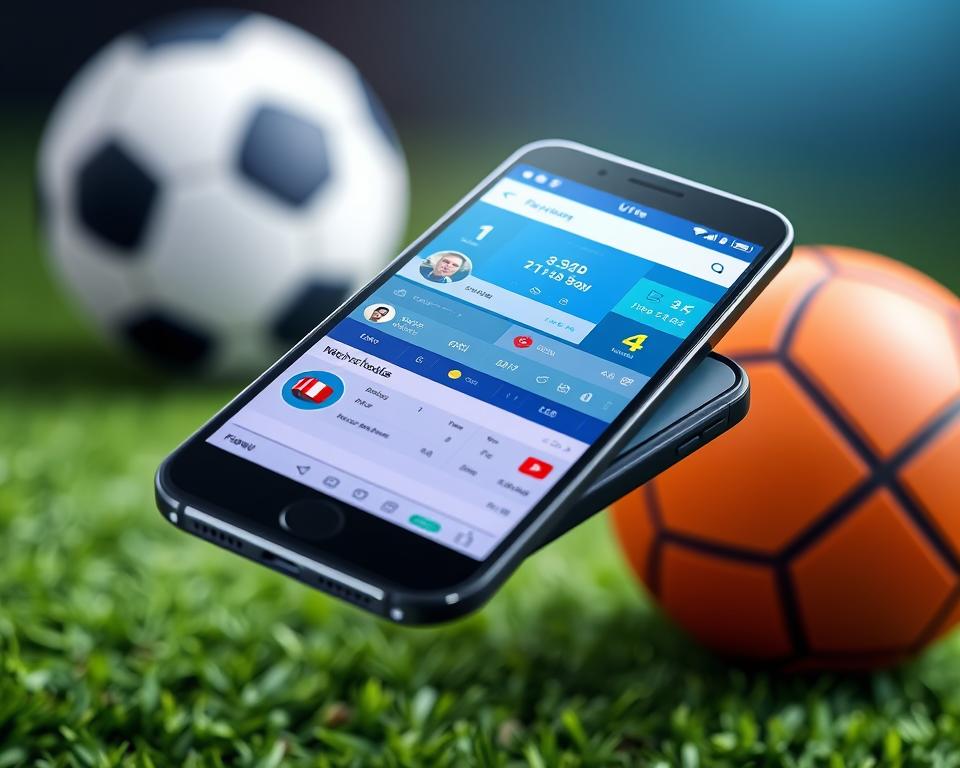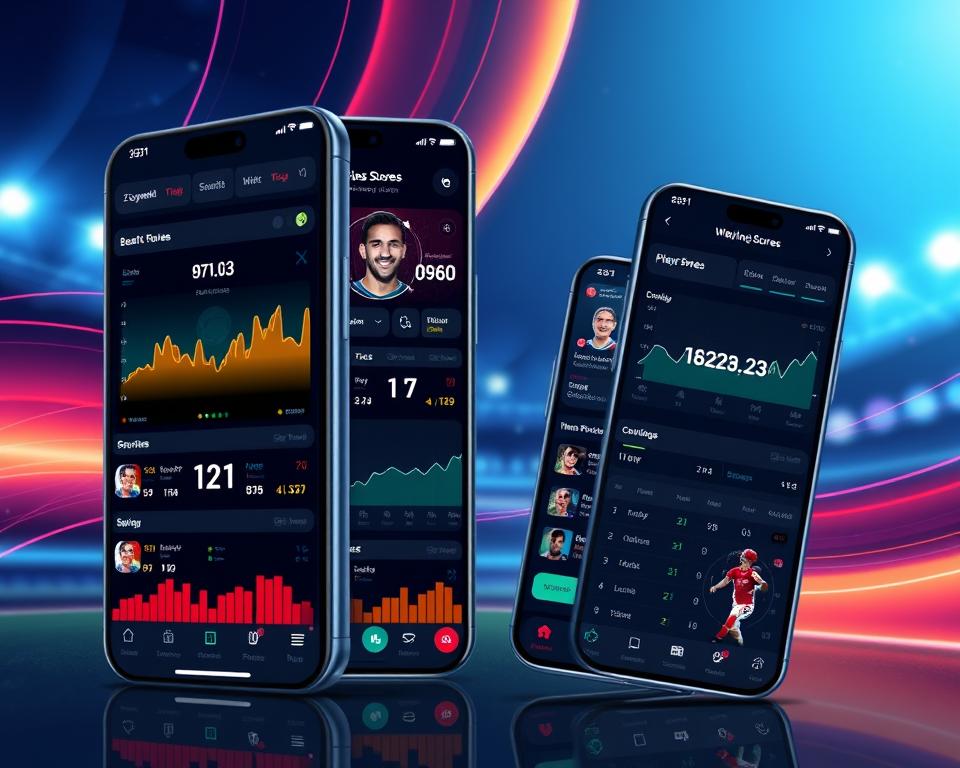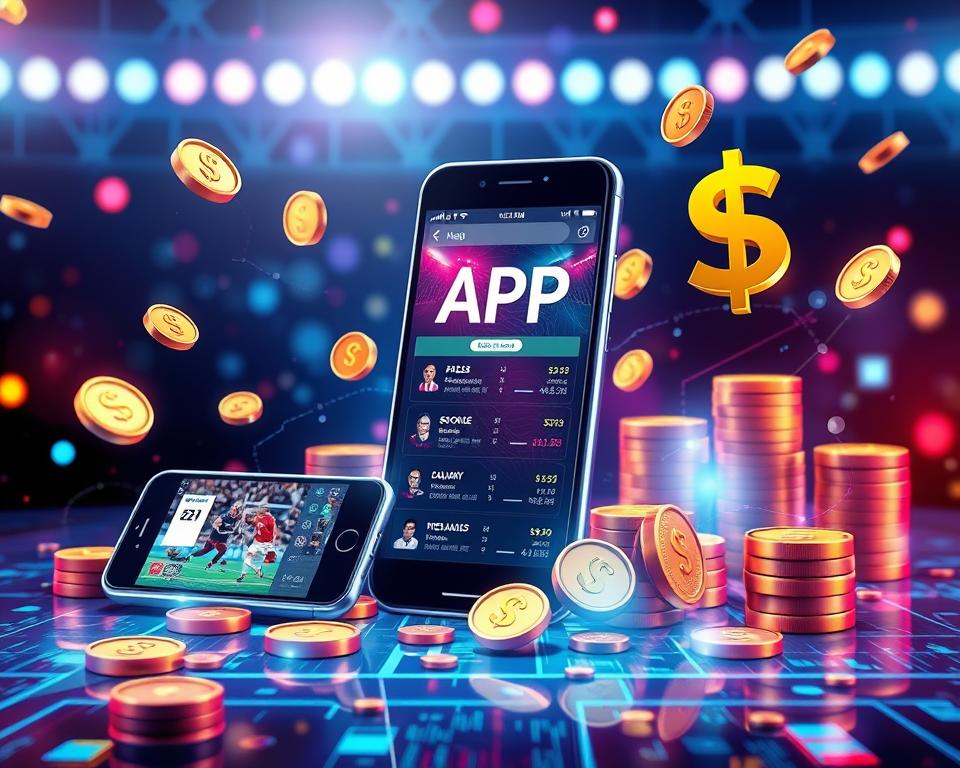In today’s fast world, sports fans want scores and updates right away. Mobile tech has opened doors for developers to make sports apps. These apps give fans what they want and help businesses grow in the sports app market.
This article will guide you through making a sports app with real-time scores and updates. We’ll look at the market, key features, and technical needs. We’ll also talk about making an app that’s easy to use and fun to interact with.
Table of Contents
Key Takeaways
- Understand the current trends and opportunities in the sports app market
- Identify the essential features that users expect in a real-time sports application
- Develop a robust technical architecture and backend infrastructure to support real-time data processing and push notifications
- Optimize the user interface and experience to create a seamless and engaging app
- Implement effective monetization strategies and revenue models to ensure the app’s long-term success
Understanding the Sports App Market Landscape
The sports app market is changing fast, offering both challenges and chances for developers and entrepreneurs. As more people want real-time sports news and personalized experiences, it’s key to know the current trends and competition. This knowledge is vital for making a successful sports app.
Current Market Trends and Opportunities
The sports app market is booming, thanks to more people using mobile devices and wanting sports info right away. Key trends include:
- Live score updates and in-game analysis for instant info
- Personalized content based on what users like and their team loyalties
- Adding social features for fans to connect and share
- More coverage of niche sports and international events to attract more users
Competitor Analysis and Market Gaps
The market is filled with big names like ESPN and theScore, plus many specialized apps. Looking closely at the competition shows gaps where new apps can stand out:
| Competitor | Strengths | Weaknesses |
|---|---|---|
| ESPN | Wide sports coverage, well-known brand | Busy interface, few personalization options |
| theScore | Easy-to-use design, focus on live updates | Not much beyond scores and stats |
| Bleacher Report | Engaging content, social features | Performance can be hit-or-miss, not much live event coverage |
Target Audience Demographics
Sports app users are diverse, with different interests and how much they engage. Knowing who to target is key to making an app that appeals to users and meets their needs. Key groups include:
- Hardcore sports fans – Deeply invested in certain teams or sports, looking for detailed analysis and updates
- Casual sports enthusiasts – Interested in sports but don’t have time for all the details
- Younger generations – Millennials and Gen Z, who prefer sports experiences that are personalized and social
By focusing on the unique needs and preferences of these groups, sports app developers can create something unique in a crowded market.
Essential Features for a Real-Time Sports Application
Building a successful sports app means giving users a full and fun experience. It needs live score updates, detailed player stats, and team standings.
Live score updates are key for fans who want to know what’s happening in their favorite games. They should get scores as they happen, so they never miss out. Also, showing detailed player stats lets fans see how athletes are doing, tracking their wins and achievements.
- Live score updates
- Detailed player statistics
- Team standings
Being able to track team standings is another big plus. It lets users see how teams are doing in the league. This helps fans keep up with their favorite teams’ progress.
A top sports app also needs customizable push notifications. These alerts send updates on game results, player news, and more. This way, fans can stay in the loop, even when they’re not using the app.
| Feature | Description |
|---|---|
| Live Scores | Provides real-time updates on the latest scores of sports events, allowing users to stay informed about the progress of their favorite teams and games. |
| Player Statistics | Offers detailed statistics and performance data for individual players, enabling fans to analyze and compare the contributions of their favorite athletes. |
| Team Standings | Displays the current standings of teams within a league or tournament, helping users track the progress and competitive position of their favorite squads. |
| Push Notifications | Sends timely alerts to users about game updates, player news, and other relevant sports information, ensuring they stay connected to the action even when they’re not actively using the app. |
With these key features, a sports app can give users a full and fun experience. It helps fans stay informed, engaged, and connected to their favorite sports.
Technical Architecture and Backend Infrastructure
Building a strong sports app needs a solid backend. It must handle real-time data and give users a smooth experience. Key parts are server scalability, database management, and API integration.
Server Requirements and Scalability
Sports fans want quick access to scores and stats. The app’s backend must handle lots of traffic, especially during big games. A scalable server setup, cloud solutions, and load balancing are vital for a smooth app.
Database Design and Management
The app’s database management is crucial for sports data. A well-designed database with fast data access is key. Also, having strong backup and recovery plans keeps data safe.
API Integration Strategies
Connecting with API providers is essential for sports apps. It brings in live scores and player stats. A scalable backend that handles API requests well is important for a good user experience.
| Feature | Importance | Implementation |
|---|---|---|
| Server Scalability | High | Cloud-based architecture, load balancing, auto-scaling |
| Database Management | High | Optimized indexing, partitioning, backup and recovery |
| API Integration | High | Scalable and flexible API management system |
Data Sources and Sports Information Providers
To make a top sports app, you need reliable data sources and sports info providers. These give you accurate, up-to-date data. This data is key for your app’s main features.
Sportradar and STATS Perform are leaders in sports data. They collect and share data from many leagues worldwide. Their real-time feeds keep your app current, making it better for users.
Accuracy is crucial for sports apps. Users want exact scores and stats right away. Working with trusted providers means your app will be reliable. This builds trust and loyalty with your users.
| Sports Data Provider | Key Features | Data Accuracy |
|---|---|---|
| Sportradar |
|
95%+ |
| STATS Perform |
|
97%+ |
Using several sports data providers and checking their data helps. This ensures your app covers everything well and is accurate. It makes your app stand out in the sports media world.
“Accurate, real-time sports data is the backbone of any successful sports app. Partnering with reputable providers is essential to building a trustworthy and engaging user experience.”
Building a Sports App That Provides Real-Time Scores and Updates
Creating a successful sports app needs a clear app development process. You must plan the technical technology stack and set a realistic implementation timeline.
Development Workflow
The steps to make a sports app include:
- Understanding what the app needs and what’s most important
- Designing the app’s look and feel
- Building the app’s backend and connecting to APIs
- Using frameworks like React Native for cross-platform development
- Adding features for real-time data and notifications
- Testing the app to make sure it works well
- Putting the app on stores and making it easy to find
Technology Stack Selection
React Native is a top choice for a sports app’s technology stack. It lets you make apps for both iOS and Android from one codebase. This saves time and money and makes sure users have a good experience everywhere.
The backend needs a server that can grow, a strong database, and APIs for sports data. Developers use Node.js, MongoDB, and RESTful APIs to build this part.
Implementation Timeline
Creating a solid implementation timeline is key for a sports app. You need to think about how complex the features are, testing, and working with outside data providers. A good timeline for a full sports app project is 6 to 12 months, based on the project’s size and resources.
By using a clear development process, choosing the best technology stack, and setting a realistic implementation timeline, you can make a sports app that gives users real-time scores and updates.
User Interface Design and Experience Optimization
In the world of sports apps, UI and UX design are key to keeping users engaged. A good design makes it easy to find scores, updates, and analysis. It’s all about creating a smooth experience for sports fans.
For sports apps, focus on these important elements:
- Intuitive Navigation: Users should find what they need fast. A clear layout and easy-to-use design help keep them happy.
- Data Presentation: Sports data can be a lot to handle. Use simple designs and interactive tools to make it easier to understand.
- Responsive and Accessible Design: People use different devices to watch sports. Make sure your app works well on all of them for a better experience.
By following these UI/UX design tips, developers can make sports apps that users love. This leads to more engagement, loyalty, and happiness.
| Key UI/UX Design Principles for Sports Apps | Description |
|---|---|
| Intuitive Navigation | Clear and logical information architecture, intuitive menu structures, and easy access to key features. |
| Effective Data Visualization | Concise and visually appealing presentation of sports data, leveraging charts, graphs, and color-coding. |
| Responsive and Accessible Design | Seamless user experience across devices and platforms, with consideration for accessibility features. |
“The best user interfaces are almost invisible to the user, allowing them to focus on the task at hand rather than the technology itself.” – Jakob Nielsen, Usability Expert
Real-Time Data Processing and Push Notification Systems
To make a sports app that updates in real-time, using the right tech is key. This includes WebSocket protocols and a strong push notification architecture.
WebSocket Implementation
Traditional HTTP can slow down real-time updates because it needs constant checks. WebSocket offers a direct, two-way link between the client and server. This means updates are sent right away, without needing to ask for them again.
Adding WebSocket to the app’s backend makes sure users get live scores and game updates fast. This makes the app better and cuts down on delays from old methods.
Push Notification Architecture
A good push notification system is also vital. It keeps users in the loop about big events, like game starts and score changes. This way, the app can share important news, even when users aren’t using it.
With a solid push notification setup, the app can use services like Apple Push Notification Service (APNS) and Google Cloud Messaging (GCM). This lets it send notifications to devices easily, keeping users up-to-date on their favorite sports.
In summary, combining real-time data processing and push notification systems is key for a top sports app. It gives users the latest info and makes their experience better.
Performance Optimization and Load Handling
As your sports app gets more popular, it’s key to keep it running smoothly. We’ll look at ways to boost app performance, use load balancing methods, and set up caching strategies.
Efficient load balancing is crucial. It spreads user requests across many servers. This stops the app from getting slow when lots of people use it, especially during big games. Use a strong load balancing system that changes based on how many users are online. This keeps your app fast and open to everyone.
Caching is also a big help. Use caching strategies to save data like team info and scores in memory. This makes your app faster and reduces server work.
Also, think about using Content Delivery Networks (CDNs) for static content like images. This makes your app load faster for users. With these steps, your sports app will run smoothly, even when lots of people are using it.
Keep working on making your app better. Always check how it’s doing, listen to what users say, and update your plans as needed. This way, your app will stay great for everyone, no matter how many users you have.
Monetization Strategies and Revenue Models
The sports app market is growing fast. App developers need new ways to make money to keep their apps alive. One big way is through subscription models. These let users pay for different levels of access, from basic to full data and live streams.
In-app advertising is another good way to make money. It lets developers show ads that fit the app without messing up the user’s experience. The trick is to find the right spot for ads without annoying users.
Premium Features
Adding premium features is also smart. These can be advanced stats, special content, or even custom app looks. By letting users buy these extras, developers can make more money from their most loyal fans.
| Monetization Strategy | Description | Potential Benefits |
|---|---|---|
| Subscription Models | Tiered access to content and features based on user payment | Stable and predictable revenue, user loyalty, ability to scale |
| In-app Advertising | Integrating targeted ads without disrupting user experience | Passive income, potential for high fill rates, data-driven optimization |
| Premium Features | Unlocking advanced functionalities and exclusive content | Increased user engagement, upsell opportunities, perception of value |
By mixing these app monetization methods, developers can build a strong and lasting money-making plan. This plan meets the needs of all users, helping the app grow and make money over time.
Security Measures and Data Protection
In today’s digital world, mobile apps deal with personal data. It’s crucial to have strong app security and data protection. Our real-time sports app will focus on keeping user privacy safe.
Encryption is key in keeping data safe. Our app will use top-notch data encryption methods. This includes SSL/TLS for secure network talks and strong encryption for data stored.
We’ll also use secure ways to check who’s using the app. This means multi-factor authentication and biometric checks. These steps help keep user info and app activities private and safe.
We’ll follow strict data protection laws, like GDPR, to protect user privacy. This means getting clear consent, keeping data to the minimum needed, and being open about how data is used.
| Security Measure | Benefit |
|---|---|
| Encryption | Protects user data during transmission and storage |
| Secure Authentication | Verifies user identity and prevents unauthorized access |
| GDPR Compliance | Ensures user privacy and regulatory adherence |
By using these security measures and following data protection guidelines, our app will earn user trust. It will keep their personal info safe, helping our app succeed and last long.
Testing and Quality Assurance Protocols
Creating a top sports app needs careful testing and quality checks. QA testing is key to make sure the app works well and feels smooth to use. Every part of making the app must be checked well to make a quality product.
Unit Testing Framework
A strong unit testing framework is the base of good software making. It breaks the app into small parts for testing. This way, bugs are found early and fixed, keeping the app solid.
Choosing the right unit testing tools, like Junit, Mocha, or Jasmine, is important. It makes testing more efficient and effective.
Performance Testing Methods
For sports apps, fast and reliable is everything. Performance testing is very important. It checks if the app can handle lots of users and data quickly.
Load testing, stress testing, and bug tracking help find and fix problems. This makes sure users have a great experience.
With a detailed QA testing plan, sports app makers can create a reliable and top-notch app. By doing thorough unit tests, improving performance, and tracking bugs well, the team can make a standout app in the market.
App Store Optimization and Launch Strategy
Creating a winning app store strategy is key for any sports app’s success. App Store Optimization (ASO) helps your app stand out in crowded stores. It makes your app easier to find for your target audience. ASO includes using the right keywords, catchy visuals, and more to boost downloads and engagement.
A solid launch strategy is also vital. It gives your sports app the push it needs at the start. Marketing before launch, teaming up with sports influencers, and focused campaigns can all help. These efforts build excitement and ensure your app gets noticed from the start.
| Key ASO Tactics | Effective Launch Strategies |
|---|---|
|
|
By using ASO and a strong launch marketing plan, your sports app can get off to a great start. This combo helps with user acquisition and long-term success in app stores.
“The key to a successful app launch is to start building anticipation and hype long before the release date.”
Analytics Implementation and User Behavior Tracking
To make your sports app a hit, you need to track user behavior well. App analytics and user data are key. They help you understand how users use your app and improve it.
Key Performance Indicators (KPIs)
Key performance indicators (KPIs) are vital for your app’s success. Focus on these important metrics:
- Daily/Monthly Active Users (DAU/MAU): See how many users are active each day or month.
- User Retention Rate: Find out how many users keep coming back.
- Session Duration: Check how long users stay in your app.
- Push Notification Engagement: See how users react to your notifications.
User Engagement Metrics
User engagement metrics show how users interact with your app. Look at these:
- Time Spent in App: Track how much time users spend in your app.
- Screen Views: See how many screens users visit.
- Content Interactions: Check how users engage with your app’s content.
- Sharing and Social Engagement: See how users share and interact socially in your app.
Use these app analytics and user behavior tools to improve your app. This way, you can make your app better and keep users coming back.
Maintenance and Update Planning
Keeping a sports app up-to-date is key to its success. Regular app maintenance, feature updates, and quick bug fixes are vital. They help keep users happy and attract new ones.
Listening to user feedback is crucial. By hearing what users say, you can make sure your app meets their needs. Using in-app surveys or customer support can give you the insights you need.
It’s also important to keep an eye on what others are doing. Look at the latest features from competitors. This helps you find ways to improve and innovate in your app.
Streamlining the Update Process
Having a good update plan is essential. It ensures your app works smoothly for users. Here are some tips:
- Set a regular update schedule, like monthly or quarterly, to keep your app current.
- Fix bug fixes quickly to keep your app reliable and smooth.
- Plan and test feature updates carefully to avoid problems.
- Share update details and release notes with users to keep them interested.
By focusing on app maintenance and updates, you can make your sports app better. This helps meet user needs and stay competitive in the fast-paced sports app market.
Conclusion
Creating a successful sports app is complex. It involves understanding the market, identifying key features, and building a strong technical base. This way, developers can make an app that grabs users’ attention and shines in a crowded field.
For an app to thrive, it must keep improving and stay in tune with user needs and trends. Watching how users act, listening to their feedback, and updating the app often are key. Also, finding ways to make money and keeping the app safe are vital for its success.
The sports app market is always changing. To succeed, an app must offer a smooth, real-time experience. It must also keep up with new tech and user wants. By using data, improving performance, and building loyalty, developers can make their apps last in the fast-paced world of mobile sports.

















